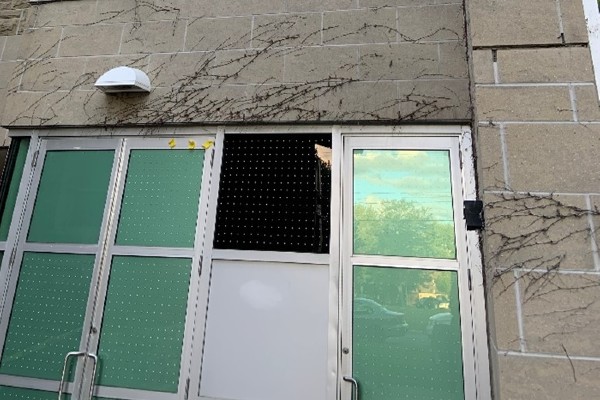Protecting birds on the wing
October 6, 2020
Share

Flocks of birds in Ontario are now on the move, flying south on their annual fall migrations. But many birds, both large and small, will not make it to their warmer destination, thanks to a largely invisible threat. Each year, millions of birds are injured or die flying straight into windows they mistake for open air. Now, Queen’s is aiming to make its campus a little safer for them to navigate thanks to new film in place over windows at select locations.
The Office of Sustainability installed the deterrent film after seeing research on bird collisions that was conducted by a Queen’s student. Combining research with sustainability, the installation has brought people from across the university together to protect the local environment.
“We are aiming to make Queen’s as sustainable as possible, and part of that work is reducing our impact on local wildlife populations. With this film in place, we expect to significantly reduce the number of birds that die from flying into windows of campus buildings,” says Nathan Splinter, Manager, Energy and Sustainability. “The project is starting off with film on the windows of one building, but we see great potential for expansion.”
The Office of Sustainability chose the Biosciences Complex as the site of the first installation of the deterrent film. In late August, Physical Plant Services placed the film on the windows of a stairwell facing Barrie Street. Humphrey-Craine Hall will receive the next installation of film in the coming months.
The deterrent film helps prevent collisions by quickly enabling birds to recognize that windows are hard surfaces. It is a decal that is applied to windows and has a small dot pattern that is visible to birds. For humans, the film is typically invisible from more than 15 feet away. And it does not affect visibility through the windows for people inside.
The installation of the film was funded by the Sustainability Working Group, which is co-chaired by Vice-Principal (Finance and Administration) Donna Janiec and Deputy Provost (Academic Operations and Inclusion) Teri Shearer. The Sustainability Working Group provides strategic direction and recommendations for the evaluation, planning, development, communication and implementation of initiatives aligned with the university’s sustainability goals and the carbon reductions targeted by the Queen’s University Climate Action Plan.
The impact of student research
This project got off the ground thanks to the research of Maleeka Thaker, a masters student studying environmental science who also earned her bachelor’s degree from Queen’s. Thaker conducted a study to find which campus buildings pose the greatest risk for bird collisions.
Under the guidance of Vicki Friesen, professor of evolutionary and conservation genetics, she shared her findings with the Queen’s Office of Sustainability. Together, they worked to develop solutions and implement them on campus.
“I started studying collisions because birds are an important part of the local environment, and I think we have a responsibility to limit the harm we do to them. When I started my research as an undergraduate, I didn’t know if I’d be able to use it to make concrete changes, so it’s very exciting to see the film installation come to life,” says Thaker. “There are many faculty, staff, and fellow students at Queen’s who worked together to make this development possible.”
Thaker became interested in studying bird collisions while taking a course with Dr. Friesen. She pursued the topic for her final project and learned how widespread the problem of birds injuring themselves against windows is, especially during migration periods.
Wanting to pursue this topic further, Thaker earned funding from the Society of Conservation Biology to conduct research on the Queen’s campus over the summer after she graduated. Thaker recruited a team of volunteers to help her methodically inspect campus locations each day for evidence of bird collisions.
Now that the film is in place on Biosciences, Thaker will be evaluating its effectiveness by comparing new data against evidence from previous inspections.
“We’re very optimistic that we will observe a significant decline in the number of birds injured or killed around Biosciences now that the film is in place,” says Thaker.
Learn more about sustainable initiatives at the university on the Sustainable Queen’s website.